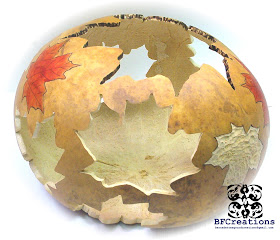I recently posted about seed swapping on my sister-blog about gardening:
bernadettesgarden.blogspot.com. I wanted to share some of the same thoughts here on my gourd blog because seed trades are an excellent way of obtaining gourd seeds, especially those hard to find types such as canteen, bushel, cannonball, and baton-shaped gourds. I'll share with you a list of DO's and DON'Ts I compiled by resourcing my experience of years of trading seeds. I hope this list help you to start off right and motivate you to try this fun winter/springtime hobby of mine.
DO's and DON'Ts:
Don't think that every seed swap will go exactly the way you
want. I suggest to do some background checking before you accept the
trade, especially if it's a large trade. (Is there a review forum for
seed swap members?)
Do think about collecting the seeds from your own garden. A
little research about each seed producing plant you grow and good timing
is all you need to harvest your own seeds. Many gardeners don't mind
cross-pollination (and a little
chaff) so go for it and have some fun with it!
Don't be neglectful on how you store the seeds you hope to trade.
Make sure you store them in a plastic bag or glass/plastic jar in a
fridge or other cool spot in your home.
Do label all your seeds clearly. It's a good practice to include the following info on each packet of seeds you send:
Name: Both common and scientific
Origins: (a) Commercial seed (purchased from a seed company), (b)
if it was collected from your garden (which means the seed was most
likely cross-pollinated and wont come true from seed), or (c) it was
from a previous trade and you are not sure of its origins. Commonly
abbreviated as: C (commercial), G (garden), and T (trade).
Year: When it was harvested.
Don't be reluctant to ask a seed trader if they will accept
things other than seeds for trade. Many seed traders have other hobbies
and interests and are willing to give seed to "add another item to their
collection." Also, include the option of giving or receiving postage
for seed. Sometimes gardeners will have an abundance of seed and are
willing to take time out and send them to whomever would like them - if
he/she is reimbursed for the postage.
Do keep records of all your seed trades. This can be very helpful
when you want to do another trade with "that person who sent me those
prized dahlias." Keep track of all the seed you sent and received, the
name and contact information of the person, and the time of year the
trade took place.
Don't forget that you can do seed trades through the mail or in
person. The master gardener next door I am sure will have some leftover
seed for you to try - and maybe she/he will want some plant tags in
return. . .
Do make sure you read up about the plants you are thinking of
starting from seed. Will they work in your climate or zone? Will you
have enough room for that shrub? Is it an invasive plant that may take
over your garden? (See:
http://invasive.org/)
Don't just send seed to wherever, you need to be careful about
regulations. If you are wondering if a certain country or state has seed
regulations then make sure you do your research before a problem
surfaces and you are fined. (See
HERE.)
Do make sure that both ends of the trade will be satisfied before the trade even begins. Converse about the exact seed you want in return and make sure you know what the other person exactly wants. Communication is key to a great trade.
Don't over extend yourself. Sometimes having too many seed trades
open can become a nightmare. One person wants this seed while two
others want the same seed, and you said "yes" to all three without
realizing it -- I think you can picture that situation pretty well.
Do make sure you read over any guidelines a seed trader may have.
Some gardeners have made seed trading a big part of their gardening and
actually made rules that, for the most part, benefit both parties if
adhered to.
Don't be stingy -- be mindful of how many seeds you place in each
packet. If there was no set seed amount discussed during the trade
conversation then assume that person will want as many seeds as you
would be happy with yourself. True gardeners are generous. Bonus packets
of seed can be your way of making a lifelong friendship.
Do send seed in plastic packets or baggies and label them
clearly. Dry seed stores the best in a sealed plastic (or glass)
container or bag so why not ship them accordingly? A snack or sandwich
bag will work okay, though freezer tough bags are better.
Don't send your seeds in paper packets unless you are planning on
using a waterproof envelope. A plastic envelope will work, as well as
wrapping a paper envelope in plastic packing tape. Remember, water could
damage the seeds inside, especially if the seeds are not planted soon
after arrival.
Do provide an organized and up to date trade list for other
people to see. Many online seed trading communities insist you have a
trade list. I insist you make sure of spelling and keep it up to date!
Don't send your seeds in a regular envelope. The seeds need to be
protected from being crushed so use a bubble envelope or wrap the seeds
in bubble wrap and place in regular envelope.
Do have fun! Make it an experience where you can learn, share, grow, and find new "flower buds."
© 2013 Bernadette Fox





























